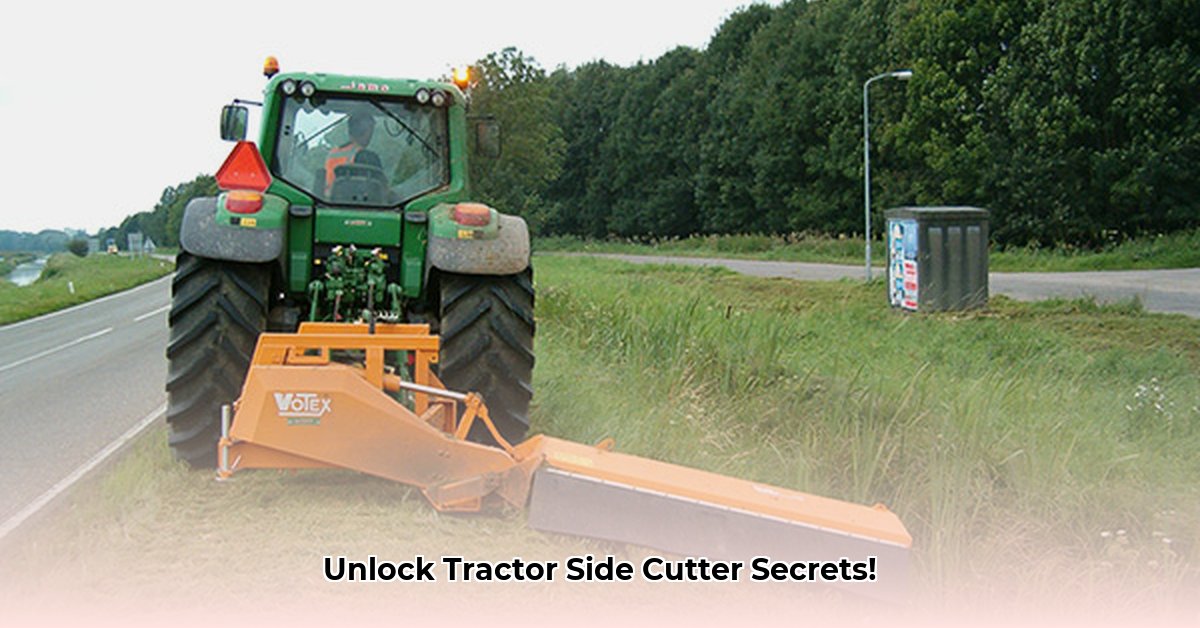
Getting the most from your tractor's side cutter is crucial for efficient and sustainable farming. This guide helps you choose between single and twin rotary mowers, optimize their use, and maintain them for peak performance and minimal environmental impact. Whether you're a seasoned farmer or just starting, this practical guide will equip you with the knowledge to mow efficiently and sustainably. For more information on subcompact tractor implements, check out this helpful resource: Subcompact Tractor Implements.
Choosing the Right Tractor Side Cutter: A Practical Guide
Selecting the ideal tractor side cutter depends on your farm's specific needs. There's no one-size-fits-all solution. The key is to carefully consider your unique circumstances.
Single Rotary Mowers: These are best suited for precision work, like trimming around obstacles or maintaining roadsides. Their narrower cutting width offers superior maneuverability in confined spaces. However, covering large areas takes significantly longer. Think scalpel, not sledgehammer.
Twin Rotary Mowers: Ideal for large fields and pastures where speed is paramount. Their wider cutting swath allows for faster coverage of expansive areas. However, maneuverability is reduced, making them less suited for intricate work. Think sledgehammer, not scalpel.
| Feature | Single Rotary Mower | Twin Rotary Mower |
|---|---|---|
| Cutting Width | Narrower | Wider |
| Maneuverability | High | Lower |
| Ideal for | Precision cutting; smaller areas | Large areas, rapid coverage |
| Efficiency | Precise, but slower overall coverage | Faster coverage, but less precise |
| Best suited for | Smaller farms, precise cutting | Large farms, open fields |
Decision-Making Roadmap: Let's create a plan to find the perfect fit.
- Land Size: Large acreage points toward a twin mower; smaller, more complex land favors single mowers.
- Terrain: Uneven terrain requires a robust mower capable of handling obstacles.
- Vegetation: Dense vegetation needs a powerful mower with strong blades.
- Budget: Establish a clear budget before you begin your search.
- Precision Needs: Prioritize either speed and vast coverage or precision cutting; your choice dictates the mower type.
Mastering Your Tractor Side Cutter: Operation and Maintenance
Maximizing your side cutter’s potential goes beyond simple operation. Proper use and diligent maintenance are crucial for both efficiency and longevity. This section provides a roadmap to success.
1. Setup: Always ensure proper blade alignment before starting; misalignment causes uneven cuts, increased wear, and potential damage. Set the cutting height based on your needs and vegetation type. This is the critical first step.
2. Operation: Maintain a consistent speed to avoid jerky movements and ensure even coverage. Overlap mowing passes to prevent missed areas. Consistency is key.
3. Safety First: Always wear appropriate safety gear: eye protection, hearing protection, and sturdy footwear. Never operate without proper training. Safety is paramount.
4. Maintenance: Regular maintenance is your best friend, both for equipment lifecycle and cost savings. Sharp blades are essential for efficient cutting and reduced fuel consumption. Regularly inspect for wear and tear on all components to prevent costly repairs and downtime. Preventative maintenance pays off.
5. Lubrication: Use eco-friendly lubricants to reduce your farm's overall environmental footprint. Follow manufacturer’s recommendations carefully.
6. Troubleshooting: Consult your owner’s manual or contact a qualified mechanic at the first sign of trouble. Never continue operating a malfunctioning mower. Prevention and prompt action are essential.
Sustainable Practices: Farming for the Future
Sustainable farming involves considering the environmental impact of your operations. Your tractor side cutter plays a significant role.
- Eco-Friendly Lubricants: Minimize your environmental footprint by choosing environmentally friendly lubricants.
- Fuel Efficiency: Proper maintenance and operation significantly reduce fuel consumption.
- Reduced Ground Compaction: Avoid excessive use of heavy equipment and implement practices to minimize soil compaction. Healthy soil is productive soil.
- Responsible Disposal: Dispose of your mower responsibly at the end of its life cycle, following local regulations.
- Technological Advancements: Stay informed about new technologies that promote efficiency and sustainability in agricultural equipment. Technological innovation continues to improve practices.
Mitigating Risks: Safety and Preparedness
Tractor side cutters, while invaluable, pose potential risks. Implementing safety measures significantly reduces these hazards:
| Risk Factor | Mitigation Strategy |
|---|---|
| Hydraulic System Failure | Regular inspections; timely fluid changes and repairs as needed |
| Blade Damage | Use high-quality blades and maintain regular sharpening schedules |
| Overheating | Follow manufacturer recommendations and allow sufficient cooling time |
| Ground Compaction | Maintain appropriate tire pressure and minimize repeated passes over the same areas |
By making informed equipment choices, employing proper operating techniques, maintaining your equipment diligently, and adopting sustainable practices you'll significantly improve efficiency, lower costs, and promote long-term land health. Remember to always consult your owner's manual and seek professional help when needed.